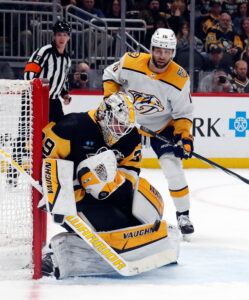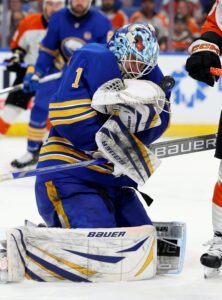The Buffalo Sabres haven’t played in a playoff game in more than a decade even though they have drafted in the top 10 on almost an annual basis. Despite the Sabres being a mess for much of this time, there have been a few instances where it seems like the team is ready to turn the corner and get back into the postseason. Last year it felt like the team would remain in contention for a wild card spot but once again they exited the playoff picture early. This year it is hard to gauge whether or not Buffalo will be in the mix as an uneven summer has left some fans scratching their heads and wondering when this team will once again be a contender in the Eastern Conference.
Draft
1-14: C Konsta Helenius, Jukurit (Liiga)
2-42: D Adam Kleber, Lincoln (USHL)
3-71: F Brodie Ziemer, USNTDP
4-108: D Luke Osburn, Youngstown (USHL)
4-123: D Simon-Pier Brunet, Drummondville (QMJHL)
6-172: D Patrick Geary, Michigan State University (NCAA)
7-204: F Vasili Zelenov, RB Hockey Juniors
7-219: G Ryerson Leenders, Mississauga (OHL)
The Sabres don’t have a ton of recent experience drafting outside of the top 10 but this year they picked Helenius with the 14th overall pick. The youngster from Ylojarvi, Finland played at home last season in the top league and registered a respectable 14 goals and 22 assists in 51 regular season games which isn’t far off of the 48 points Aleksander Barkov’s scored in the league as an under-18-year-old. Helenius plays a high-energy game and plays much bigger than his size, he is a good forechecker and is responsible defensively. Helenius does everything pretty well and should be a good two-way player in the NHL.
Buffalo selected Kleber in the second round after he helped Team USA earn bronze at the 2023 Hlinka Gretzky Cup last summer. The massive 6’6” defenseman is committed to playing next season at the University of Minnesota Duluth and should continue to develop into a strong defensive defenseman. Kleber isn’t the prettiest skater, but he gets around the ice well for a big man which allows him to cover a lot of ground in the defensive zone. His offensive instincts aren’t strong, nor is his ability with the puck but he does offer a solid breakout pass which should aid him in his defensive work.
The Sabres used their third-round pick to draft another undersized forward in Ziemer who had a solid season with the U.S. National Team Development Program tallying 27 goals and 43 assists in 61 games which was good enough for fourth on the team in points. Ziemer has a good shot and is good in tight spaces around the net, his offensive instincts allow him to find soft areas on the ice to capitalize on breakdowns in coverage.
Trade Acquisitions
F Ryan McLeod (Edmonton)
F Tyler Tullio (Edmonton)
Buffalo traded Matthew Savoie to the Edmonton Oilers for McLeod and Tullio in what many analysts felt was a sell-low move by the Sabres. Savoie was drafted ninth overall by the Sabres in the 2022 NHL entry draft and many believed he would be a huge part of their core moving forward. But with the trade to Edmonton, all of Savoie’s upside goes out the door and Buffalo makes the move for the player who is a safer bet but has a much lower upside.
McLeod is a proven NHL player, and at just 24 years old he has improved in every NHL season. Last year he tallied 12 goals and 18 assists in 81 regular season games but had just four goals in 24 playoff games. McLeod has some upside of his own and is a bit of an analytics darling, but if his finishing abilities remain the same, Buffalo could end up coming out on the bad end of the trade.
UFA Signings
F Nicolas Aube-Kubel (one-year, $1.5MM)
F Josh Dunne (two-year, $1.55MM)*
D Dennis Gilbert (one-year, $825K)
F Mason Jobst (one-year, $775K)*
F Sam Lafferty (two-year, $4MM)
F Brett Murray (one-year, $775K)*
D Jack Rathbone (one-year, $775K)*
G James Reimer (one-year, $1MM)
D Colton Poolman (one-year, $775K)*
G Felix Sandstrom (one-year, $775K)*
F Jason Zucker (one-year, $5MM)
* denotes a two-way contract
The Sabres bought out Jeff Skinner this summer and opened up a significant amount of cap space which excited Sabres fans that the team would make some big moves to try and get back into the playoff picture. Ultimately the team whiffed in free agency and settled into a series of underwhelming signings that appeared more like panic moves than pieces of a plan falling into place.
Zucker is a solid NHL veteran who has been a 20-goal scorer in the NHL on multiple occasions. However, the fact that he was the Sabres big splash certainly alarmed some fans. Zucker can still play but is overpaid at this stage of his career and isn’t much of a playdriver. Zucker has struggled to stay healthy throughout his career but could provide the Sabres with solid veteran minutes if he can remain in the lineup.
Lafferty is another former Pittsburgh Penguin who is a solid depth forward. He finally had a breakthrough in recent seasons and was terrific last year for the Vancouver Canucks posting a career-high 13 goals and 11 assists in 79 games. While Lafferty has firmly established himself as a regular NHLer, he isn’t going to move the needle offensively or offer a significant improvement on some of the Sabres departures from last season.
Aube-Kubel is another fourth liner that the Sabres brought in to try and improve their bottom six. The 28-year-old has been a solid pro for several years but is a few seasons removed from being a good fourth-line scoring option and a $1.5MM AAV feels like an overpay given the players that remain on the free agent market who are still looking for work and are likely to sign for league minimum.
RFA Re-Signings
D Jacob Bryson (one-year, $900K)
D Kale Clague (one-year $775K)*
D Henri Jokiharju (one-year, $3.1MM)
G Ukko-Pekka Luukkonen (five-year, $23.75MM)
F Beck Malenstyn (two-year, $2.7MM)
* denotes a two-way contract
Buffalo’s big RFA signing was locking up netminder Luukkonen to a five-year deal. UKL could be poised for a breakout season and the Sabres opted to lock him up and avoid having to dish out a more significant extension in the near future. The 25-year-old’s new deal does come with a significant amount of risk though as last year was his first season as a starter and his sample size beyond that isn’t overly big.
Buffalo also acquired Malenstyn in a trade with the Washington Capitals that was received with lukewarm reviews at best. Malenstyn then signed a two-year extension with the Sabres and will most likely be counted on to play fourth-line minutes. He plays an honest game, gets around the ice well and should open up room for his teammates but given what the Sabres gave up getting him, they better hope that the 26-year-old has more to his game than what he showed in Washington.
Departures
F Brandon Biro (Seattle, one-year, $775K)*
D Joseph Cecconi (Minnesota, one-year, $775K)*
G Eric Comrie (Winnipeg, one-year, $825K)
D Jeremy Davies (Ottawa, one-year, $775K)*
F Zemgus Girgensons (Tampa Bay, three-year, $2.55MM)
C Tyson Jost (Carolina, one-year, $775K)
F Victor Olofsson (Vegas, one-year, $1.075MM)
F Justin Richards (signed with Düsseldorfer EG of the Deutsche Eishockey Liga)
F Eric Robinson (Carolina, one-year, $950K)
F Matthew Savoie (traded to Edmonton)
D Calle Sjalin (signed with Rögle BK of the SHL)
F Jeff Skinner (Edmonton, one-year, $3MM)
D Riley Stillman (Carolina, one-year, $775K)*
G Dustin Tokarski (unsigned UFA)
F Linus Weissbach (signed in SHL)
* denotes a two-way contract
Buffalo’s biggest departure was Skinner who left the team after a volatile six seasons. Skinner was a 40-goal scorer in Buffalo in his first season but never lived up to expectations after signing his eight-year $72MM extension in June 2019. He did score 30 goals in three of his six seasons in Buffalo, but his shortcomings defensively became too much to ignore, particularly when he went into scoring droughts.
The remaining Sabres departures were of the depth variety, with most of them being players who were playing in the team’s bottom six. Girgensons moved onto Tampa Bay after ten years in Buffalo, and while it is always difficult to see a tenured player leave town, his on-ice production should be easy to replace.
Olofsson is a three-time 20-goal scorer and scored 28 goals just last year but given how little he provides when the puck isn’t going in, Buffalo opted to move on from the player. Olofsson can skate and can create offense with his playmaking as well, but his defensive shortcomings became a problem in Buffalo, and his size created more issues, particularly when contests became physical.
Salary Cap Outlook
Buffalo enters August with just under $8.5MM in projected cap space which is more than enough room to sign their remaining RFA Peyton Krebs. The Sabres are positioned well for the future as most of their core is locked up long-term to reasonable contracts and the cap will be increasing in future seasons. The Skinner buyout will be a burden between 2025-2027, which makes the decision to buy him out this summer all the more puzzling given that they still haven’t utilized that additional cap space to get better.
Key Questions
Can The Scorers Rebound? Almost all of Buffalo’s offensive stars struggled last season, with some of them taking massive dips in production. The hope is that a new coaching staff can spark the offense to get back to their offensive numbers from the 2022-23 season. Buffalo doesn’t have a lot of offensive pieces in their bottom six, which creates additional pressure on the top two lines. Tage Thompson will be counted on to stay healthy and get back to the 40-goal mark as will Dylan Cozens and Alex Tuch who both had 20-point drops last season.
Will Jack Quinn Stay Healthy? Quinn has dealt with a series of injuries in his first two seasons as an NHLer, and while the former eighth-overall pick has been productive when healthy, he still needs to prove he can play for an entire season. The Cobden, Ontario native is likely to be a fixture in the Sabres top-6 for years to come, but first, he must prove he can be a fixture for an entire season. Quinn had nine goals and 10 assists in 27 games last season which averages out to a 58-point pace over an entire season and demonstrates just how effective Quinn can be offensively when he is healthy. Much of the Sabres playoff hopes will rise and fall on the performance of their top-6 and if Quinn can be a regular contributor, it will be huge for Buffalo.
Can Lindy Ruff Change This Group? Ruff was hired to bring change into the organization by teaching this group structure and how to be accountable to each other. But the biggest thing the Sabres need Ruff to bring is stability given that Ruff was fired by Buffalo during the 2012-13 season and since then the Sabres have had six head coaches and no playoff appearances. The Sabres need Ruff to find a balance between letting the stars play and also having everyone buy into a system that allows the team to win games and get back to the playoffs. Ruff may or may not be the coach to do that and he likely wasn’t at the top of many wish lists in Buffalo, but he will have the team working hard and playing for each other, which might be just the thing to get the team back into the playoff picture.
Photos courtesy of USA Today Sports Images.

